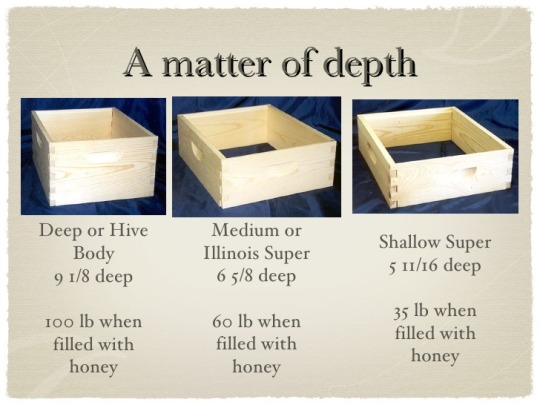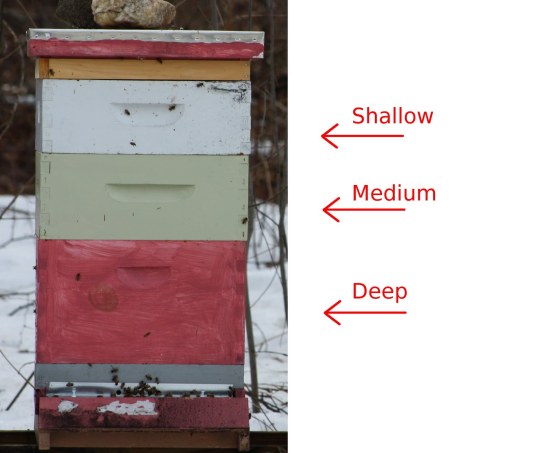Novice urban beekeeping. gsBEES: A student group at the Harvard University Graduate School of design.
Don't wanna be here? Send us removal request.
Photo



Today we invited more interested students to the hives and sadly confirmed the death of both hives from what we believe was a combination of disease, winter cold, and mite infestation. We examined the frames noticing where the dead bees clustered in the winter for warmth before passing. There were also signs of hive distress from limited brood production and what looked like large, oversized brood of potential queens to replace a missing or unproductive queen. Thanks to everyone who helped, and we’re hoping to give folks more access to hands-on beekeeping this spring through site visits.
0 notes
Photo

Today when checking on the hives we saw 3 large queen cells on one frame. Unfortunately, this means that the queen is most likely distressed, dead, or swarmed away. We made a note on the top of the frame to check 4 days later to see if a queen has hatched.
0 notes
Text
Checking for Varroa Mites with Drone Brood
Today, we checked on the hive we treated for Varroa Mites by using a drone larva similar to the method described here. We identified the drone brood by it’s larger size and cap and opened it with a hive tool to see if a small brown mite was preying on the larva at the base of its head. It was hard to sacrifice a drone but helped us know that the hive wasn’t suffering from a large infestation.
0 notes
Text
Summer Activity: Adding a Shallow Super & Naming New Hive, Pinus Strobus
Taking note of the warm, humid temperatures this summer, we added a shallow super and shallow frames to the top of the hive from Weeping Pine Apiaries. Now that the shy queen seems to be back laying lots of new brood, we wanted to make sure they had enough space and ventilation for the summer. If not, the colony may get too large and feel crowded and decide to swarm away from the hive.
To celebrate the queen and hive settling in, we decided to name this new hive Pinus Strobus, which is the Latin name for Eastern White Pine.
For some background info on the different between a deep or shallow super, here are some reference images.


0 notes
Photo

Greg explained to us how you can identify drone brood which is larger and more raised than regular worker brood.
0 notes
Photo

Checked on new hives today and looked for new, healthy brood. Here’s a photo of light colored, yellow, fresh brood nicely filling out a good portion of one side of a frame. Greg talked to us about checking not only for light yellow color but also quantity. If it looks like there are large gaps and many empty spots between brood, it’s a sign the queen isn’t laying at full capacity and may be distressed or that the hive is unhealthy. Darker, more brown brood is older and also a sign that the hive’s health isn’t doing well.
0 notes
Photo

#OldBrood #NewBrood #BusyBees #UrbanBeekeeping (at Harvard University Earth and Planetary Sciences)
0 notes
Text
Summer Activity: Ventilation
As the temperature rises, we are refilling a small tupperware container with large rocks in it about every 4 days. The bees need the rocks to land on and like to have a nearby water source.
Additionally, we removed the entrance reducers we had on when we installed the hives in late spring and adjusted the inner and outer coverings at the top to maximize ventilation. For more info on the parts of a Langstroth Beehive, here’s a helpful image.

0 notes
Video
instagram
Lovely conversation with John Mailloux of Weeping Pine Farm & Apiaries while picking up the new nuc. John clarified some safety and installation questions for us including why not to eat bananas before handling bees and the development of bee allergies when you’re exposed to pollen and honey but don’t get stung for a long time. Thanks, @amalgorithm, for the pics!
0 notes
Video
instagram
Spring nuc pick-up at Weeping Pine Farm and Apiary in Williamstown, VT. We had a great drive up through New England including a fire tower hike at Mt. Moosilauke, Chris stumbling on a moose den, a granite quarry in Graniteville and the rocket in Warren, NH! 3-2-1 blast-off! Due to the apiary's namesake, our new hive's name will be the weeping pine, Pinus Strobus. So happy to welcome them back to Cambridge for the summer.
0 notes
Photo


Screened this amazing documentary, Queen of the Sun, What are the bees telling us? last night with pizza, wine, and great discussion. Awesome cameos from local New England organic beekeeping legend Kirk Webster and a host of lively characters.
0 notes
Text
Winterizing
This year we talked to Greg and referred to the following suggestions for what we did to winterize the hives against the cold. 1) Placed entrance reducers 2) Made sure that the front door is not blocked by dead bees or debris, restricting access to vitally important airflow 3) Adjusted the inner and outer cover to insulate. When you put the inner cover on the hive, generally you'd have the knotch up in the winter, and the knotch down in the summer. But, there is an article here that having the knotch down would allow air to circulate better. 4) Placed a brick on top of the hive cover so it does not blow away
Additional suggestions have been 1) Homasote boards under the inner cover to absorb moisture. We have some that we can use for next year.
2)Wind-proofing around the hive
3) Adding black tarps or lining to absorb sunlight and heat.
0 notes
Text
Varroa Mite Board Checks
A constant challenge to a colony’s health is mite infestation. The most common mites are varroa and tracheal mites.
We researched varroa because we suspected that might have caused some bee casualties near the hive we notice one day while feeding the bees sugar water. One helpful link describes what to look for and some background on the mites, which were introduced to Florida in the 1980s and are incredibly nasty parasites that embed themselves inside the bees.
We checked on the varroa mite population this fall using mite boards. There are a couple methods we referenced on one link on how to count the mites on the board after leaving them on the screened bottom board for a few days. You can attempt to estimate the population of varroa depending on the number of days you’ve left the mite boards in to collect droppings from the hive. We estimated that the population had not reached a point where treatment was necessary.
This link also references an organic varroa mite treatment method involving the dusting of powdered sugar.
0 notes
Photo

#HoneyHoney Tasting and Sale today during Beer N Dogs 7pm! (at GSD Gund Hall)
0 notes
Text
Sugar Water Feeding Post Honey Extraction
After our fall honey extraction, we wanted to make sure the bees could use the honey we left for the winter and decided to feed them sugar water before it got too cold.
Taylor had suggestions for a feeding the bees every 4-5 days or whenever we noticed the sugar water supplies were empty. We used a 2:1 white sugar to warm water mixture in small ziploc bags with slits cut on top place above the frames above the inner wooden cover.
It seemed to work alright though there were some concerns with feeding regarding bags smothering some bees and possibly introducing moisture into the hives with the sugar water when there was some leakage.
There are a few other methods we will try next year with a black frame feeder that we have that replaces one of the empty frames in a super. There is also an external jar feeder that fits in the hive entrance with a wooden entrance reducer though that carries the risk of tempting other colonies from stealing from the hive. We noticed that when a new nuc arrives, a metal can filled with sugar water with a very small hole cut at its base provides a steady food source as well. You can just place the can in a medium, shallower super above the frames below the inner wooden cover.
0 notes

